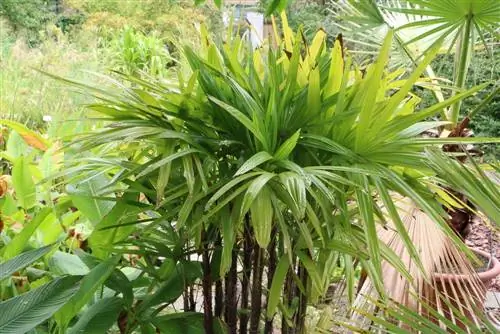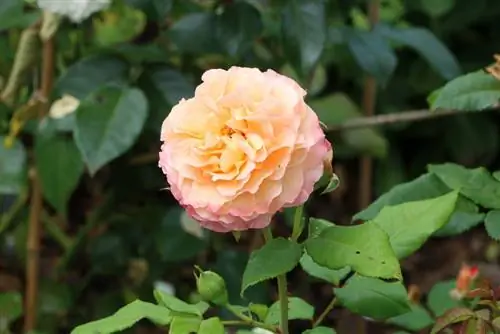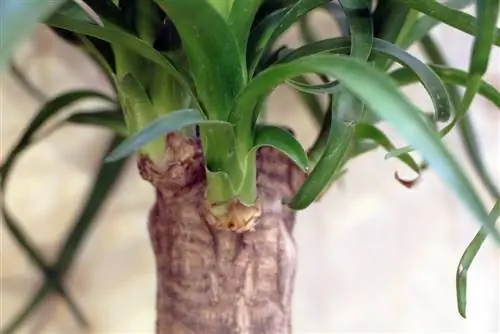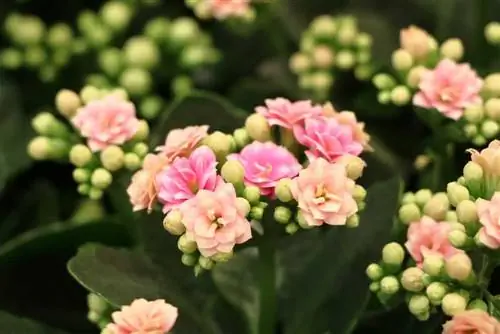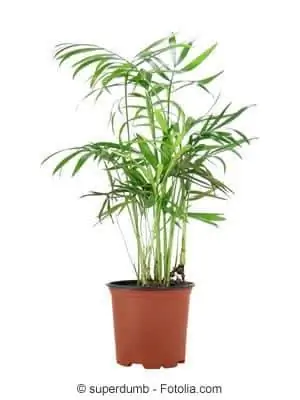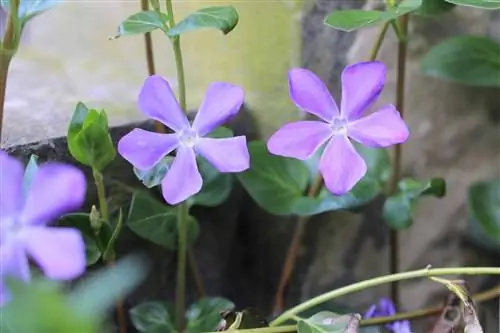- Author admin [email protected].
- Public 2023-12-17 03:39.
- Last modified 2025-01-24 12:45.
In modern interior design, large house plants create an authentic bridge between nature and design. Their evergreen foliage is therefore very popular for creating a relaxing atmosphere in living rooms, business premises and offices and for filtering the air we breathe. So that the convincing advantages do not have to be paid for with time-consuming care, the selection should not be based solely on the optical attributes. We looked around the wide range and discovered 12 really large houseplants for you that are also easy to care for.
Really big houseplants from A to K
Birch fig (Ficus benjamina)
This classic among the really large house plants is more popular today than ever. The birch fig has all the properties we want from an indoor tree. The dense foliage impresses with elegant, shiny, slightly wavy leaves. Depending on the variety, the decorative leaves remain uniformly green or set decorative accents with a cream-green marbled play of colors. The more pronounced the color, the sunnier the location should be. In addition, the mulberry plant is undemanding. Watering with room temperature water and fertilizing every 6 weeks from March to September will keep the elegant tropical beauty happy. The only drawback is the poisonous plant sap, which can cause allergies if it comes into contact with the skin.
Growth height as a houseplant: 4 to 5 m
Dracaena marginata and Dracaena fragans)
If you are looking for a houseplant with monumental dimensions, the fascinating dragon tree comes into focus. Dense clusters of leaves with lanceolate leaves in attractive colors from rich green to golden yellow to red-green stripes thrive on its sturdy trunks. The two species Dracaena marginata and fragans stretch up to the ceiling, while other species remain at waist height. The palm-like growth belies the fact that this is actually an asparagus plant, which is therefore easy to care for and tolerates cutting. This really large houseplant prefers to stay in a partially shaded location at a pleasant 18 to 25 degrees Celsius. Abundant watering in summer and reduced watering in winter are the most important rules in the care program.
Growth height: 2 to 3 m
Window Leaf (Monstera)
The window leaf casually shook off his dusty image. For indoor gardeners of all generations, the large tropical plant is now more popular than ever. Their windowed decorative leaves are also a familiar image in business premises, open-plan offices and entrance halls. To create a decorative background in popular television series, the majestic window leaf is always the first choice. The arum plant owes its cult status not only to its 100 cm large leaves and extensive growth. His good-natured character is also expressed in uncomplicated care, which poses no hurdles even for beginners. The location should be partially shaded to shady and have as high a humidity as possible. If the substrate dries, water it. The nutrient supply is limited to the addition of liquid fertilizer to the irrigation or spray water at 14-day intervals.
Growth height: 2 to 5 m
Fishtail palm (Caryota mitis)
In the ranking of magnificent house plants in XXL format, the fishtail palm rightly occupies a place at the top. The sublime palm differs from its counterparts at first glance thanks to its beautiful, double-pinnated palm fronds, which are reminiscent of a fish tail and can reach a width of at least 120 cm. During this growth, each leaf divides into further sections, creating an extra densely bushy appearance. In addition, rapid growth and easy care characterize the powerful plant that will tower over your gardener in no time. The room giant shows its best side at temperatures between 20 and 30 degrees Celsius and in a place in the sun. Regular watering with lime-free water covers the high water requirements in summer.
Growth height: 2 to 10 m

Tip:
Large houseplants depend on a high-quality substrate that is permeable, structurally stable and has first-class buffering power. Conventional potting soil from discount stores usually does not meet these requirements, but is suitable as a basic component for the right mixture. By adding clayey garden soil, perlite and quartz sand, you create a premium quality potting substrate.
Fiddleleaf fig (Ficus lyrata)
With its bombastic stature and huge, lush green leaves, the violin fig meets contemporary tastes perfectly. The mighty shrub or small tree from the rainforest impresses with violin-shaped leaves that are up to 45 cm long and 28 cm wide. If you want a really large houseplant, this type of fig will not take long to torture you until it reaches its final height. Its diverse attributes include rapid growth, so that it reaches the ceiling within just a few years. The pivotal point in the uncomplicated care program is a bright, not full sun location. If you keep the substrate constantly slightly moist and add liquid fertilizer to the water every 4 weeks in summer, your exotic roommate will feel right at home
Growth height in indoor cultivation: 5 to 10 m, rarely up to 16 m
Kentia palm (Howea forsteriana)
A really large houseplant with a wow effect is finding its way into your home with the Kentia palm. The single-stemmed palm boasts elegant, overhanging pinnate leaves. A care program at beginner level as well as a wide range of locations make the slim exotic one of the most popular large plants. It thrives equally he althily and vitally in sunny, partially shaded and low-light places. However, the Australian palm tree takes some time until it reaches the desired dimensions. If the slow growth doesn't bother you, the Kentia palm is one of the easiest-care foliage plants for living and working spaces. From spring to autumn it needs to be watered regularly and abundantly. In winter the only thing that should be avoided is dryness of the bales. You can save yourself the hassle of moving to winter quarters because the exotic animal really likes room temperatures all year round.
Growth height: 2 to 4 m
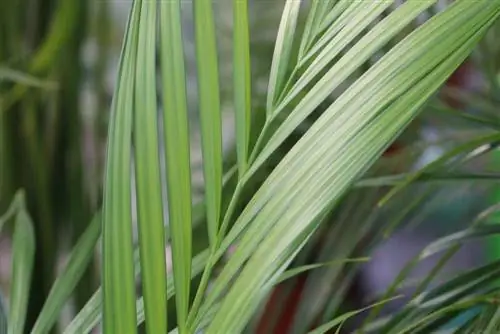
Large houseplants R to Z
Giant palm lily (Yucca elephantipes)
A list of really large houseplants is only complete when the giant palm lily is included. The Mexican asparagus plant is the favorite for beginners and advanced users if a dominant and easy-care ornamental plant is desired for creative living space greening. Its tightly upright, pointed sword leaves demonstrate the proud self-confidence of a plant that cannot be disturbed by anything. Even if the gardener isn't particularly careful about watering, a giant palm lily doesn't go to waste. Nevertheless, a moderate water balance and monthly fertilization are beneficial in order to get the best out of the giant. If the magnificent specimen still outgrows you, cutting it back will restore its shape.
Growth height: 3 to 5 m
Tip:
Decorative leaves covered in dust not only convey an unkempt appearance. The dust layer also prevents pollutants from being filtered out of the air. Therefore, wipe the leaves once a week with a damp, soft cloth.
Giant-leaved arrowleaf, elephant ear (Alocasia macrorrhizos)
The green crowd favorite is record-breaking in many ways. The giant-leaved arrowleaf achieves its towering size in no time. The largest individual leaves in the plant kingdom unfold, measuring up to 120 cm long and 50 cm wide on 130 cm long petioles. The huge leaves have an arrow-shaped shape and are reminiscent of large elephant ears, which underlines the tropical magic of this floral superstar. Despite its impressive height, the alocasia impresses with its slim elegance without appearing bulky. In order to enjoy this floral splendor, a humid location up to room temperature sets the stage. A permanently moist substrate without waterlogging and 14 days of fertilization in spring and summer keep the noble rainforest beauty happy.
Growth height: 2 to 4 m
Tip:
Hard tap water is not comfortable even for large houseplants. Let the water sit for a few days before using it for watering or spraying. Ideally, you would pamper your frugal roommates with collected rainwater.
Columnar cactus (Cereus peruvianus)
As the epitome of the desert plant, the columnar cactus puts other large plants in their place in terms of dominance and undemandingness. A long, slender trunk has several branches, characterized by 8 to 10 strong ribs. With its dense coat of thorns, the XXL cactus keeps predators at bay in the wild and should therefore only be cared for with thorn-proof gloves. Very often, caring for a columnar cactus is not on the agenda. Regular watering in summer is the key function in the care program. Wherever the exotic survival artist likes it, he surprises with nightly flowers. While foliage plants filter the air, the columnar cactus makes itself useful by absorbing wave radiation from computers, televisions or microwaves.
Growth height: 5 m and higher
Hollow palm, bamboo palm, rod palm (Rhapis excelsa)
She disappeared into obscurity for decades. Since the beginning of the 20th century, people have probably simply had enough of the ubiquitous palm tree in living and working spaces. With the desire for ever larger houseplants, the mighty bamboo palm is now experiencing a furious comeback because it is also easy to care for. Their fan leaves, up to 30 cm wide, on slender stems are a feast for the eyes and harmonize wonderfully with several unspoilt trunks that are covered in thick fibers. The magnificent rod palm provides convincing evidence that beginners do not have to start their career as an indoor gardener with small plants. When placed in a bright location and watered when the soil is dry, this care completely covers the modest requirements.
Growth height: 2 to 4 m
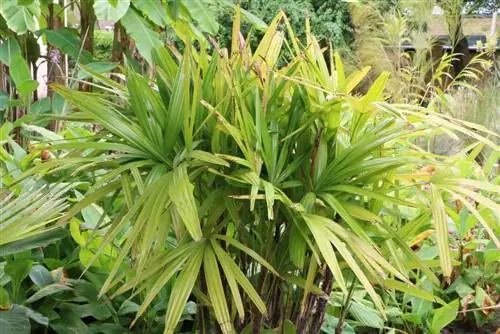
Radiant Aralia, Finger Aralia, Large-leaved Schefflera (Schefflera actinophylla)
The Radiant Aralia brings the opulence of the rainforest directly into your living room. Within the diverse species society, Schefflera actinophylla is considered the undisputed record holder in terms of size growth. Its tightly upright, smooth trunk has countless, five-part leaves in a star-shaped arrangement, which is where their various names come from. It is said that large amounts of positive energy are stored in its leaf fingers, which a fingered aralia generously shares with its gardener. The large-leaved Schefflera is therefore one of the typical Feng Shui plants in China and worldwide. The powerful beauty requires little horticultural attention to develop in all its glory. The most important premise is a bright to sunny location where temperatures do not climb below 15 degrees or above 25 degrees Celsius.
Growth height in indoor culture: 2 to 4 m
Ornamental banana (Musa basjoo)
With its huge leaves and monumental habit, the ornamental banana spreads a paradisiacal jungle atmosphere in large living rooms and winter gardens. Since this type of banana comes from Japan, it is much more robust than tropical specimens. This benefits from uncomplicated cultivation, which is determined by a warm, moist summer and a cool, dry winter. After 3 to 8 years, the magical floral creature blooms for the first time with red to purple flowers. The resulting fruits are not edible because a sufficiently long ripening period is not possible in the Central European climate. The most important aspect of care is a daily patrol with the watering can in summer time, because the water requirement is at a high level.
Growth height: 3 to 6 m
Conclusion
These 12 really large houseplants make an unmistakable statement in your living space, without any horticultural pitfalls in care. From the gigantic violin fig to the rediscovered window leaf to the furious banana plant, you can discover a wide range of majestic plant beauties here. The most important premises in cultivation are protection from the blazing summer sun, a regular water supply, monthly fertilization and an average minimum temperature of 12 to 15 degrees Celsius. Where these basic conditions are given, the plants forgive one or two beginners' mistakes and still achieve expansive dimensions in XXL format.

